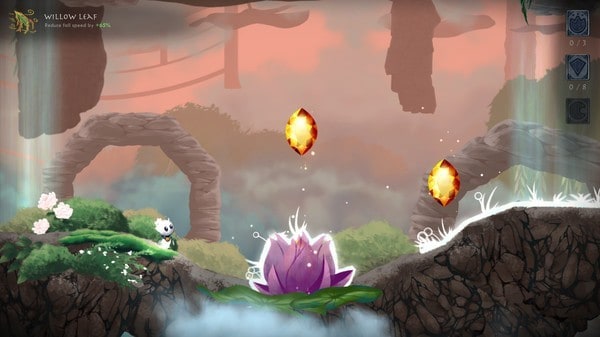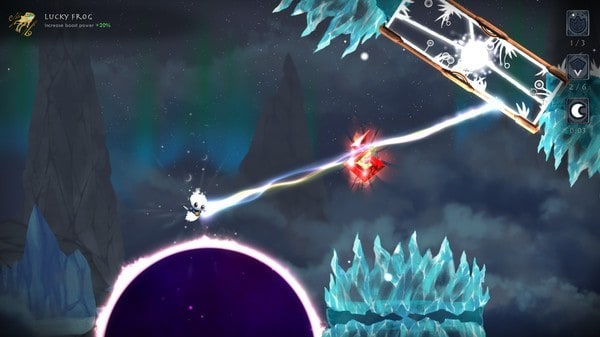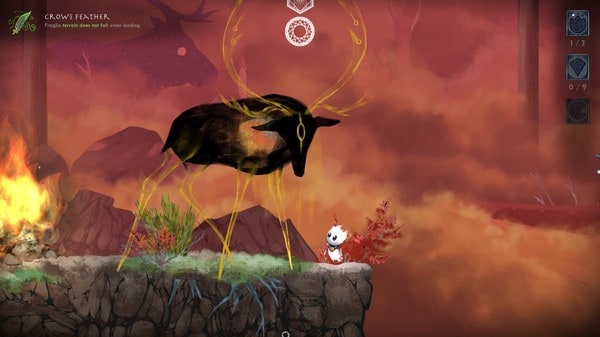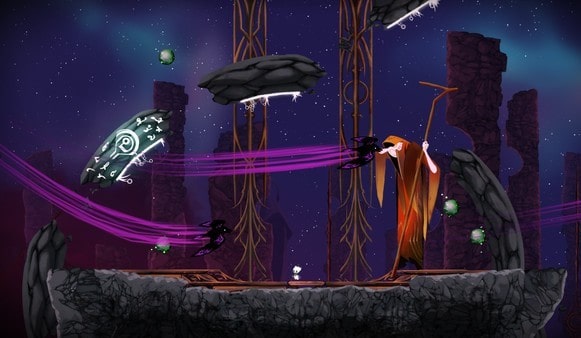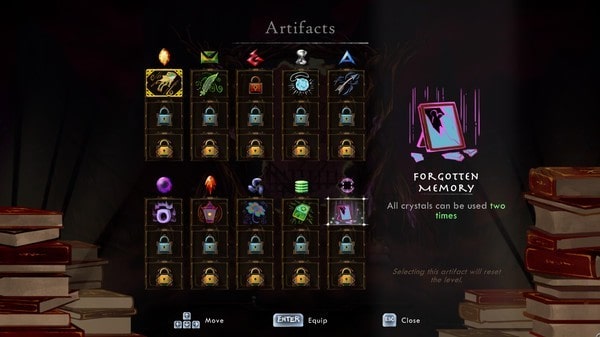Red Stewart reviews Evergate for PC (Steam)…
Developed by Stone Lantern Games LLC and published by PQube Limited, Evergate is one of the best puzzle platformers I have played in a while. I know I usually begin these reviews with an extravagant introduction talking about the antiquity of a genre or a personal experience I had that relates to the current game, but the thing is I’ve already spoken extensively about puzzle platformers in the past- that they are about fresh mechanics. And Evergate left such a strong impression on me that I feel the need to immediately get into the review!
As always we’ll start with the story, of which there actually is one. Fans of puzzle games know that, since the days of Tetris and Super Mario Bros., narratives have often been pushed to the side in favor of focusing on the gameplay. In Evergate, though, a surprisingly large mythos has been created by Stone Lantern to support their world- spirits of recently deceased humans are sent to an afterlife called the Phyrgia Realm to be reincarnated through a device known as the, you guessed it, Evergate.
One of these spirits is Ki, whose appearance in Phyrgia triggers an astral storm that unleashes dark faeries and scorches the Evergate, the latter having the effect of providing Ki with access to past memories: something that should not be possible for souls. Why is this happening and what is Ki’s role in all this? You’re going to have to play the game to find out, though I will say don’t expect anything extravagant. Evergate’s biggest issues in the storytelling department are that it’s conflicted in its presentation and wrapped in surface-level sentimentality. You’re not getting much in the way of character development or even character depth- heck, for the vast majority of its runtime, Ki acts like a silent protagonist.
By conflicted presentation I mean it genuinely feels like there was a split in the fictive direction: half the team wanted a straightforward mnemonic tale while the other half was more in favor of subtly conveying a generational drama through limited dialogue and illustrations, and unfortunately a couple of problems arose from the clash: not only do the two parts not mesh well together, but the direct yarn is noticeably inferior to the elusive one as the aforestated sentimental tone diminishes its quality. Thankfully, it never approaches tearjerker territory, however I’ll be danged if this wasn’t one of the cheesiest scripts I’ve read in an indie game. I’m sure people will criticize me for being too harsh on this front, but considering how beautiful some of the pictorial storytelling could get, I feel justified. These images appear whenever you reach the midway point of a chapter or close it out altogether, and are rendered with simple shapes, striking hues, and dynamic character poses: telling a quick story in a small number of panels, much like a Peanuts yonkoma strip.
That makes a good transition to the graphics. Right from the get-go, one of the things you’ll notice about Evergate are the seamless transitions. Seriously, from the title page to the main game there isn’t a single loading screen, which is a damn impressive feat considering next generation consoles are marketing themselves on providing this aspect.
But that wouldn’t matter if the game itself wasn’t visually up-to-par, and thankfully that isn’t the case here. Evergate might very well contain my favorite depiction of the Great Beyond aesthetically- the hub Ki returns to after every adventure is a library full of misty clouds and contrasting light and dark hues, showcasing the blend of Heaven and Hell influences. An enchanting starry sky protrudes in the background, while the Evergate itself is two gnarled trunks wrapped around one another; simple yet alluring.
That amalgamation of nature and the metaphysical extends to every single world you enter, of which there are many. In having to revisit these memories, Ki travels through a diversity of locales, ranging from Ancient China to a techno-future, and the artistry never fades. Blocks and platforms may float and exude a sense of spacetime displacement, but they’re visibly made of a tangible Earthen material, whether rock, brick, or metal. Walls may be lined with glowing white lights or strange flora, but they’re clearly composed of everyday ice, stone, or grass. This was a good decision because it both helps ground Evergate in a realistic schema, and gives it an alien-enough look that is inherently enthralling. Too often you see renditions of eternity go in one direction or the other, being either a mirror reflection of the real-world or a completely altered plane of existence, and both extremes end up feeling lackluster and improbable. By striking a balance, Evergate avoids those pitfalls and crafts an ideal theoretical model of the hereafter.
In terms of the art style itself, that’s a bit harder to describe. I’m admittedly limited in my descriptors due to not being a drawer or painter, but what Stone Lantern has gone for here resembles something I’d expect out of a modernized Sega classic. The environments are obviously not photorealistic, but they are CGI constructions that are desperately trying TO replicate the physical world. A look at the old Sonic games or Nights into Dreams perfectly encapsulates what I mean. Note that, in spite of my use of the word “desperately,” I am not degrading the efforts- the game looks gorgeous.
One of the more interesting design choices is the implementation of 2D elements amidst a 2.5D world. If anyone has ever played the Paper Mario series, you are more than familiar with the flat characters who look like they are literally flipping when they turn from side-to-side, and that’s the case here. Everyone besides Ki is literally a wafer-thin product that seems like they were made of colored stationery, and that partly extends to the ecological and manmade environs of the area: some of the aforementioned obstacles appear three-dimensional, others (like the collectables) are more papery, yet what’s fascinating is that none of them look out of place. There was real effort put into ensuring that these different stylistic choices polymorphed well with one another, and the end result is a sight to behold.
Lighting, on the other hand, is pretty limited. At first Evergate starts off very well through Ki herself. She has an in-built luminescence that literally lights up her surroundings wherever you go, and what’s amazing is how authentic the radiance is- it only extends to her immediate vicinity, nothing greater and nothing less, which is how lamp-like bodies actually work. The same applies to Ki’s laser and the power-up boxes, but more on that later.
In spite of this, most of the main illumination is prerendered for each level, though that isn’t inherently bad. It means everything is appropriately lit beforehand, and so you will never have to worry about adjusting your brightness- a sunny vista is just as pleasant to gaze at as a war-torn city. My quandary is I do feel that, given the mystic standards set-up by the Phrygia Realm itself, more could have been done with the lighting systems to provide an overarching arcane atmosphere.
Some other graphical feats that I want to mention yet can’t organically fit into the paragraphs above are the following: whenever Ki moves, she causes a kinetic chain reaction on anything in her terrestrial proximity, causing things like flowers or the robes of the other spirits to flutter. Very impressive, as is the motion of the little feather-like hairs on her head. The backdrops of every place are also magnificently crafted, and worthy of being wallpapers on their own.
If there is any complaint I have about the graphics, it would be the rehashed animations used to depict progress from location to location and the Evergate to produce a new book of memories.
Next up is sound. You do get some grunts and laughter during the storyboard sections, but for the most part there is no voice acting, meaning we are going to begin with the SFX. What you get here is pretty standard for an indie game- you have a lot of pre-programmed noises for actions, that do not deviate no matter the external factors: shattering barriers, triggering boosters, jumping, and more all contain the same sound regardless of whether you hit it at a different angle or land with a different velocity. That being said, I did not consider it a big issue here due to the stages being relatively short, and you thus not having to spend an inordinate amount of time listening to them to the point of annoyance.
The music, credited to a composer named M. R. Miller, is….a tough thing to talk about. Miller is very talented, able to adjust his OST to fit whatever era the Evergate takes you to, and he’s able to do that adjustment without it feeling stereotypical or in-your-face. For example, talking about the first area in China, there are those traditional strings associated with classical Oriental melodies incorporated into the track, but they never come off as a western impression you would hear in some hack’s studio. Likewise, the music of the future sections features electronic beats thumping throughout, yet they never takeover to turn it into a synthwave-esque harmony.
For all these feats, though, the issue I have is that there is an optimism present in the vast majority of the score that is at odds with the increasingly-dark direction the story takes. As Ki advances further and learns more, the plot turns grimmer with tragic truths and revelations. And when your encompassing story is heading towards that tone, it feels a bit jarring to get interrupted with happy orchestral leitmotifs that parade along. This isn’t on Miller as it is a direction issue, but his compositions do unfortunately suffer as a result. When the tone of Evergate aligns with the music, it works wonders, but when it doesn’t, it took me a out of the game at times. But that could very well just be me.
Finally, we get to the section I have been waiting to talk about, and that is of course the gameplay. Evergate is built around a mechanic called the “Soulflame,” a targeting system that Ki uses to manipulate objects around her. Most of the time, it comes down setting-off preplaced “power-ups,” resembling gems, that cause a variety of effects. Gold ovals, for example, blast you into the air, orange stars turn you into a fiery wisp, and hourglasses instantly teleport you amongst a plethora of others.
When I said in the beginning of this review that Evergate was one of the best platformers I have experienced, it was primarily derived from the implementation of these chargers, and their relationship with the level layout. A lot of effort was evidently put into the design of each part, with supplements placed at specific points to ensure that they aren’t wasted- every single one of them serves a purpose, and using them for the wrong one or to trigger a cheap shortcut will cost you something unless you are aiming to just speed through to the end (in which case, why are you even playing a puzzler?).
See, all the arenas contain three specific goals that you have the option of completing: one, beat the level in a set amount of time; two, activate all the power-ups, and three, collect all these moon shards. Successfully accomplishing any of them will earn you essence, which in turn unlocks bonus levels, as well as charms that you can equip to Ki in order to give you an extra ability: a higher leap, faster movement, bigger portal creation, stealth from enemy ships, etc….there are many of them that you can experiment with, and you will definitely need them for the higher levels should you want to finish those additional targets.
The best part about these targets is that they don’t work like the full-sync objectives from the Assassin’s Creed series- complete one of them and it will be saved, allowing you to focus on the others on additional replays. At first I thought this was done to avoid inducing frustration, but I immediately realized that it was actually a deliberate choice- it would be impossible for the player to successful attain all three in a single playthrough due to each having their own mini-navigation challenges. Absolutely amazing, and a natural way of creating replay value.
That being said, I will say that some of the timing required to trigger the motes can be a little irritating and lead to extensive trial and error. I also wasn’t a huge fan of certain charms being necessary for beating certain objectives as it sometimes made them too reliant on gimmicks over player skill, though opinions will vary.
So, what do you get with Evergate? You get a damn good platformer, that’s for sure. A unique esthetic, dazzling visuals, and well-arranged stages keep things constantly entertaining. And though there are flaws with the sound design and even power set-ups, I think you will be pleased with everything.
It took me a little over 6 hours to beat Evergate, and, at a $20.00 asking price, this would normally be at odds with my $1 : 30 minutes ratio. However, you will get further mileage from 100 percenting all the levels, as well as completing the bonus areas (both of which I did not have time to do).
Still, if I am being honest, those will probably only net you two hours more, keeping the total at 8 and still below 10. However, given that Stone Lantern Games is an indie company, and given the sheer amount of creativity on display here, I am inclined to make an exception to my rule.
Pros:
+ Mesmerizing art
+ Seamless transitions
+ Replay value
+ Creativity
Cons:
– Mediocre story
– Music at odds with the narrative
Rating – 7/10
Red Stewart

